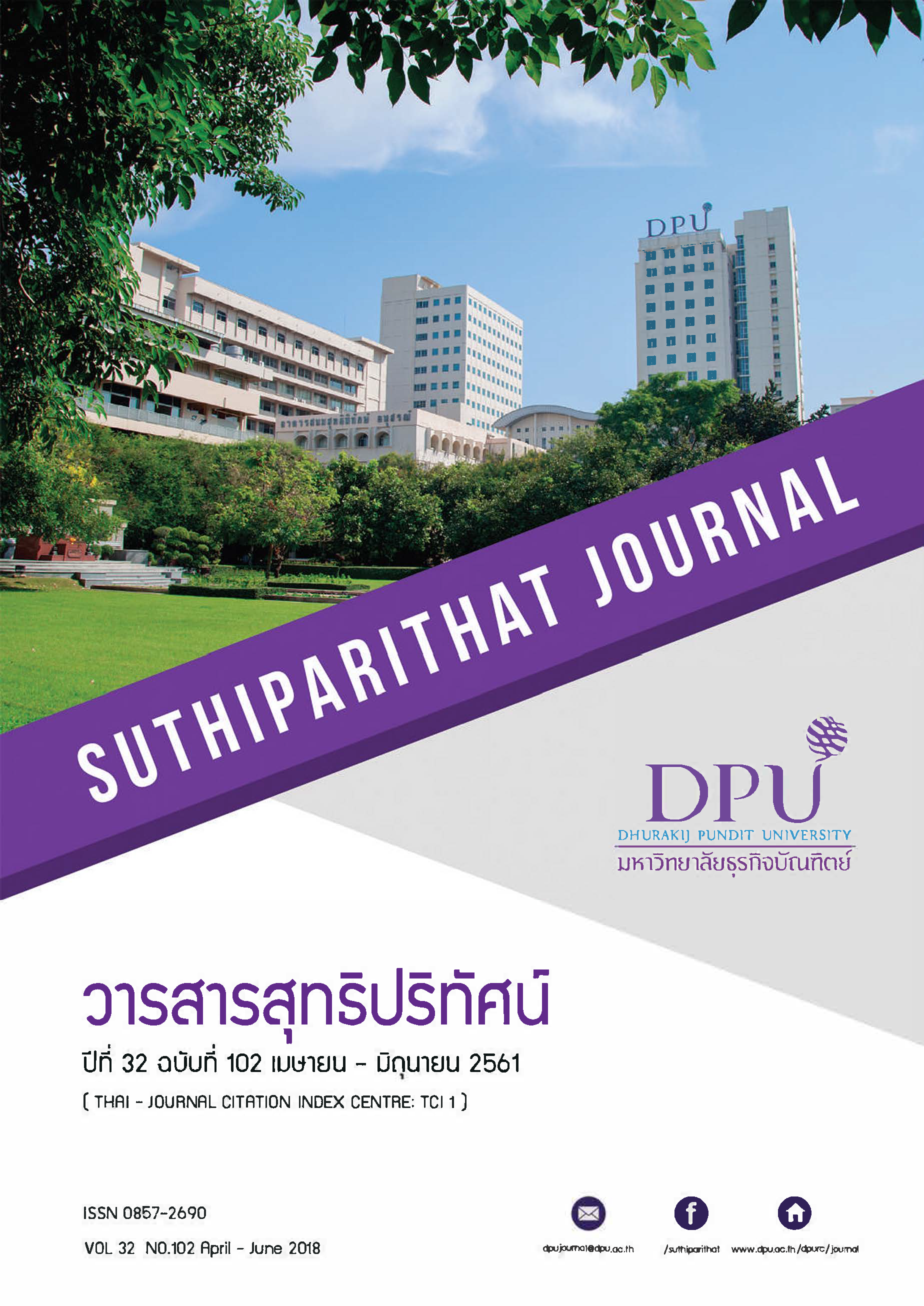แนวคิดทางทฤษฎีของการประกันภัยรายย่อย
คำสำคัญ:
ประกันภัยรายย่อย, แนวคิดและทฤษฎีเศรษฐศาสตร์เชิงพฤติกรรมบทคัดย่อ
บทความนี้เป็นบทความทางวิชาการเกี่ยวกับการประกันภัยรายย่อยหรือไมโครอินชัวรันส์สำหรับ ผู้มีรายได้น้อยวัตถุประสงค์ของบทความนี้เพื่อทบทวนวรรณกรรมการประกันภัยรายย่อยที่เกี่ยวกับแนวคิด และทฤษฎีทางเศรษฐศาสตร์เชิงพฤติกรรม ซึ่งได้แก่ แนวคิดเกี่ยวกับพฤติกรรมด้านความเสี่ยงของแต่ละ บุคคลและทฤษฎีอรรถประโยชน์ที่คาดหวัง แนวคิดเกี่ยวกับพฤติกรรมการไม่ชอบความสูญเสียและทฤษฎี ความคาดหวัง แนวคิดเกี่ยวกับพฤติกรรมความกลัวความไม่แน่นอนและแนวคิดเกี่ยวกับพฤติกรรมของ บุคคลที่พึงพอใจในการได้รับผลตอบแทนในปัจจุบันมากกว่าอนาคต (Hyperbolic Discounting) นอกจาก นี้ ในการทบทวนยังได้นำเสนอการทดสอบแนวคิดและทฤษฎีในทางปฎิบัติ ซึ่งจากการทดสอบทำให้พบ ปัจจัยหลายอย่างที่อาจมีส่วนสำคัญต่อความต้องการผลิตภัณฑ์ประกันภัยรายย่อยและการขยายการเติบโต ของอุตสาหกรรมประกันภัยในตลาดเกิดใหม่
References
เกษรา ธัญลักษณ์ภาคย์ และ ฐิติเทพ สิทธิยศ. (2557). การทดสอบข้อสมมติของทฤษฎีเศรษฐศาสตร์เกี่ยวกับความมีเหตุผลของมนุษย์: หลักฐานเชิงประจักษ์จากการทดลองในระบบปิด. วารสารเศรษฐศาสตร์ธรรมศาสตร์, 36(3), 1-30.
ธเนศร์ ศรีวิชัยสำพันธ์. (2559). เอกสารคำสอนวิชาทฤษฎีเศรษฐศาสตร์จุลภาค 1. เชียงใหม่: คณะเศรษฐศาสตร์ มหาวิทยาลัยเชียงใหม่.
นภดล ร่มโพธิ์. (2555). การตัดสินใจโดยใช้ทฤษฎีอรรถประโยชน์ (Utility Theory). วารสารบริหารธุรกิจ คณะพาณิชยศาสตร์และการบัญชี มหาวิทยาลัยธรรมศาสตร์, 35(134), 12-15.
บุญเลิศ จิตรมณีโรจน์. (2554). Economic Review 12 การเงินเชิงพฤติกรรม (Behavioral Finance). รายงานเศรษฐกิจและธุรกิจรายเดือนมหาวิทยาลัยหอการค้าไทยและหอการค้าไทย, 7(3), 12-15.
Alary, D., Gollier, C. & Treich, N. (2012). The Effect of Ambiguity Aversion on Insurance and Self-protection. Presented Paper, the World Risk and Insurance Economics Congress (25-29 July 2010 in Singapore). Retrieved February 13, 2018, from http://idei.fr/sites/default/files/medias/doc/by/treich/effect_v2.pdf
Ashraf, N., Karlan, D. & Yin, W. (2006). Household Decision Making and Saving Impacts: Further Evidence from a commitment Savings Products in the Philippines. Paper series. The Economic Growth Center, Yale University, New Haven. Retrieved December 10, 2017, from www.econ.yale.edu/growth_pdf/cdp939.pdf
Azfar, O. (1999). Rationalizing hyperbolic discounting. Journal of Economic Behavior & Organization, 38(2),245-252.
Bryan,G. (2013). Ambiguity aversion decreases demand for partial insurance: Evidence from African farmers. Unpublished Manuscript. London School of Economics, London. Retrieved December 10, 2017, from https://pdfs.semanticscholar.org/5f3a/aad3734656774159f53875914b382e657715.pdf
Churchill, C.& Matul, M. (2012). Protecting The Poor: A Microinsurance Compendium. Vol. II, Geneva: International Labour Organization. Retrieved December 10, 2017, from http://www.ilo.org/wcmsp5/groups/public/---dgreports/---dcomm/---publ/documents/publication/wcms_175786.pdf
Cole, S. A., Gine, X., Tobacman, J., Topalova, P., Towsend, R.& Vickery, J. (2013). Barriers to Household risk management: Evidence from India. American Economic Journal, 5(1), 104-135.
Cole, S. A., Gine, X., & Vickery, J. (2013). How does risk management influence product decisions? Evidence from a field experiment. World Bank Policy Research Working Paper N0.6546. United State: World Bank. Retrieved December 10, 2017, from http://www.hbs.edu/faculty/Publication%20Files/13-080_138f3c30-b5c2-4a97-bf56-9821f89fcbd3.pdf
Clarke, D. & Kalani, G. (2011). Microinsurance decisions: Evidence from Ethiopia. Unpublished Manuscript. University of Oxford, UK. Retrieved December 10, 2017, fromhttp://citeseerx.ist.psu.edu
Dercon, S., Gunning, J. W., & Zeitlin, A. (2011). The demand for insurance under limited credibility: Evidence from Kenya. Unpublished Manuscript. Oxford University, UK. Retrieved December 10, 2017, from https://aae.wisc.edu/mwiedc/papers/2011/Zeitlin_Andrew.pdf
Dror, D. M. & Piesse, D. (2014). What is Microinsurance? (May 8, 2014). Chapter 2 in: A Practical Guide to Impact Assessments in Microinsurance (preliminary version) Edited by Ralf Radermacher and Katja Roth Published by the Microinsurance Network and Micro Insurance Academy, May 2014. Retrieved December 10, 2017, from https://ssrn.com/abstract=2434501
Elabed, G., & Carter, M. R. (2015). Compound-risk aversion, ambiguity and the willingness to pay for microinsurance. Journal of Economic Behavior & Organization, 118, 150-166.
Ellsberg, D. (1961). Risk, Ambiguity, and the savage axioms. Quarterly Journal of Economics, 75(4), 643-669.
Fudenberg, D. & Levine. D. K. (2006). “A Dual-Self Model of Impulse Control.” American Economic Review, 96(5), 1449-1476.
Gine, X., Menand, L., Townsend, R. & Vickery, J. (2012). Microinsurance: A Case Study of the Indian Rainfall Index Insurance Market. In Handbook of the Indian Economy, edited by Chetan Ghate, 167–94. New York: Oxford University Press.
Gine, X., Towsend, R., & Vickery, J. (2008). Patterns of rainfall insurance participation in rural India. World Bank Economic Review, 22(3), 539-566.
Hill, R. V., & Robles, M. (2011). Flexible Insurance for Heterogeneous Farmers: Results from a Small-Scale Pilot in Ethiopia. IFPRI Discussion Paper, International Food Policy Research Institute, Washington, DC.
Hillson, D. & Murray-Webster, R. (2007). Understanding and Managing Risk Attitude. Surrey: Gower Publishing
Ito, S., & Kono, H. (2010). Why is the take-up of microinsurance so low? Evidence from a health insurance scheme in India. Developing Economics, 48(1), 74-101.
Kahneman, D., & Tversky, A. (1979). Prospect Theory: An Analysis of decision under risk. Econometrica, 47(2), 263-291.
Karlan, D., Osei, R., Osei-Akoto, I., & Udry, C. (2014). Agricultural decisions after relaxing credit and risk constraints. Quarterly Journal of Economics, 129(2), 597-652.
Lloyd’s of London. (2009). Insurance in developing countries: exploring microinsurance and other commercial opportunities. Lloyd’s 360 Insight and the Microinsurance Centre, London. Retrieved December 10, 2017, from https://www.lloyds.com
Martinez-Correa,J. (2012). Risk Management and Insurance Decisions under Ambiguity. Presented Paper, The Brown Bag Seminar, The Department of Risk Management and Insurance, Georgia State University. Retrieved February 12, 2018 from http://excen.gsu.edu/fur2012/fullpapers/jcorrea2.pdf
Mobarak, A., & Rosenzweig, M. (2013). Informal risk sharing, index insurance and risk taking in developing countries. American Economic Review, 103(3), 375-380.
Patt, A., Peterson, N., Carter, M., Velez, M., Hess, U., & Suarez, P. (2009). Making index insurance attractive to farmers. Mitigation and Adaptation Strategies for Global Change,14(8), 737-753.
Platteau, J., De Bock, O., & Gelade, W. (2017). The demand for microinsurance: A literature review. World Development, 94, 139-156.
Rabin, M. (2000). Risk Aversion and Expected-utility Theory: A Calibration Theorem. Econometrica, 68(5), 1281-1292.
Rubinstein, A. (2003). Is It “Economics and Psychology”?: The Case of Hyperbolic Discounting. International Economic Review, 44(4), 1207-1216.
Stein, D. (2011). Paying premiums with the insurer’s money: How loss aversion drives dynamic insurance decisions. Retrieved February 12, 2018, from https://pdfs.semanticscholar.org/9b6d/ca9175de3b0c5c73d052bd3d209245398724.pdf
Swiss Re. (2009). World insurance in 2008: life premiums fall in the industrialised countries. Sigma No.3/2009, Zurich. Retrieved December 10, 2017, fromhttp://institute.swissre.com.
Swiss Re. (2010). Microinsurance-risk protection for 4 billion people. Sigma No.6/2010, Zurich. Retrieved December 10, 2017, from http://institute.swissre.com.
Swiss Re. (2011). Insurance in emerging markets: Growth drivers and profitability. Sigma No.5/2011, Zurich. Retrieved December 10, 2017, from http://institute.swissre.com.
Swiss Re. (2016). Mutual insurance in the 21st century: back to the future?. Sigma, No.4/2016, Zurich. Retrieved February 13, 2018, from http://institute.swissre.com
Swiss Re.(2017). World insurance in 2016: The China Growth Engine Steams Ahead. Sigma, No.3/2017, Zurich. Retrieved December 10, 2017, from http://institute.swissre.com
Tversky, A., & Kahneman, D. (1981). The Framing of Decisions and the Psychology of Choice. Science, New Series, 211(4481), 453-458.
Tversky, A., & Kahneman, D. (1992). Advances in prospect theory: Cumulative representation of uncertainty. Journal of Risk and Uncertainty, 5(4), 297-323.
Wakker, P., Thaler, R., & Tversky, A. (1997). Probabilistic insurance. Journal of Risk and Uncertainty, 15(1), 7-28.
Downloads
เผยแพร่แล้ว
How to Cite
ฉบับ
บท
License
เนื้อหาและข้อมูลในบทความที่ลงตีพิมพ์ในวารสารสุทธิปริทัศน์ ถือเป็นข้อคิดเห็นและความรับผิดชอบของผู้เขียนบทความโดยตรงซึ่งกองบรรณาธิการวารสาร ไม่จำเป็นต้องเห็นด้วย หรือร่วมรับผิดชอบใดๆ
บทความ ข้อมูล เนื้อหา รูปภาพ ฯลฯ ที่ได้รับการตีพิมพ์ในวารสารสุทธิปริทัศน์ ถือเป็นลิขสิทธิ์ของวารสารสุทธิปริทัศน์หากบุคคลหรือหน่วยงานใดต้องการนำทั้งหมดหรือส่วนหนึ่งส่วนใดไปเผยแพร่ต่อหรือเพื่อกระทำการใด ๆ จะต้องได้รับอนุญาตเป็นลายลักษณ์อักษรจากวารสารสุทธิปริทัศน์ก่อนเท่านั้น






